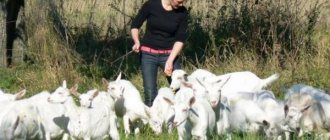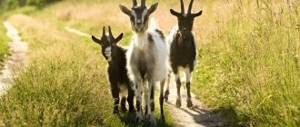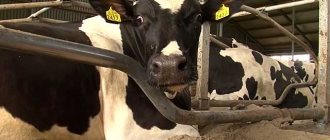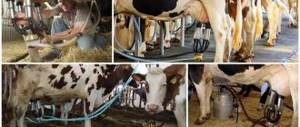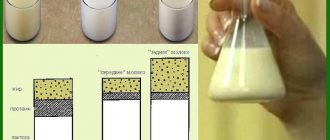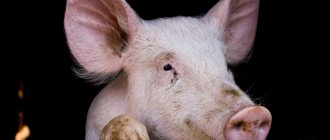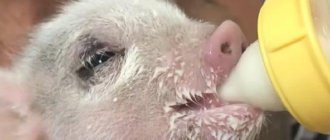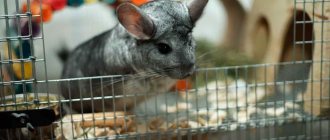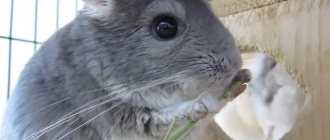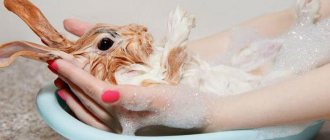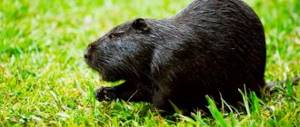Why should you trim?
Goat hooves grow throughout the animal's life. If they are not in constant movement on hard surfaces, the legs become overgrown with cartilage tissue. The platform becomes uneven and lumpy. Pets experience severe discomfort. They are susceptible to injury. Incorrect positioning of the legs provokes bone deformation and joint inflammation. The goat begins to limp and have difficulty moving.
The owner must ensure regular pruning. Due to the poor condition of the legs, the goat loses productivity (this indicator is affected by any stress on the goat’s body). To carry out such an operation you will need a tool. If a farmer is doing this for the first time, it is better to ask for the help of an experienced person to avoid injury to both the pet and his own hand.
Important! Trimming a goat should be done carefully and in compliance with safety precautions.
Why are goats' hooves trimmed?
All goats have to regularly trim their hooves and treat them. As they grow, they become clogged with dirt and injure the animal’s legs. Goats stop running, lose their appetite, then try to move less and lie down often. They become obese and their milk yield decreases. A goat with untreated hooves may position its feet incorrectly and have problems eating and drinking. Joint deformation often occurs. Parts of untreated hooves that dig into the skin injure it, the wounds easily become infected, and inflammation begins. The animals are unsteady on their feet and lame.
Under natural conditions, goats rub off the built-up stratum corneum on rocks or hard soil, so pruning is not required. When kept at home, they move much less; in winter they are on the thick bedding of a barn, so they need help. Goat kids have their hooves trimmed from the age of 3 months.
Expert opinion
Zarechny Maxim Valerievich
Agronomist with 12 years of experience. Our best country expert.
Ask a Question
If there is an asphalt surface near the livestock breeder’s house, in the summer, to remove the accumulated keratinized layer, it is enough to drive the animals on a hard surface once a day. They should walk about 1 kilometer.
Why is the procedure needed?
Throughout its life, an animal's hooves grow, so they need to be trimmed. As in the case of human nails, if you do not touch the growths, they will dig into the skin and cause discomfort when walking.
In their natural environment, goats walk on rocks, so their hooves wear down on their own on the rough surface of the soil, and it is not possible to completely fill the void with dirt. This does not happen on pasture or in home care.
In winter, due to constant keeping indoors with soft bedding made of straw or fabric, the hooves grow even larger and faster.
If you refuse to regularly trim, the following problems may occur.
- overgrown hooves, on which growths in the form of horns form, and dirt becomes clogged. It, in turn, is a favorable environment for the development of bacteria, and as a result, one often has to deal with rotting.
- A goat's legs, when the surface on the hooves is uneven, do not have the necessary stability, and this is fraught with dislocations of the limbs and even fractures.
- Changes in gait are also associated with lack of hoof care. Even a healthy animal develops problems with joints, and lameness often develops.
- A goat will not be able to eat or even drink normally if its legs are positioned incorrectly.
An animal with overgrown hooves experiences constant pain, so it tries to lie down most of the time. In this case, the amount of milk yield and productivity decreases.
Hoof trimming is not a surgical procedure, but you will still need to be careful not to snag the skin or soft tissue.
Why is hoof trimming necessary?
The hoof is a hard horny formation. If we compare the anatomical structure, the hoof is similar to human nails. It is a so-called modified skin, where the lower layer of the epidermis is a callus. Goats' hooves grow throughout their lives. Therefore, cutting off excess growths is extremely necessary. Wild animals in natural conditions can independently grind off excess tissue, as they move on hard surfaces, which allows the hoof formation to grind down. Excess growths on the hooves create uncomfortable conditions for goats.
Failure to carry out this procedure in a timely manner can lead to incorrect positioning of the legs, as well as problems with joints, pain, and the animals will have difficulty moving. During the winter period, the hoof layer grows, as animals move less and are mostly indoors on bedding. Therefore, goat hoof trimming is carried out in spring and autumn. In the summer, animals move a lot on pastures, thereby naturally grinding off excess formation. For any animal, this procedure is stressful, so preparing the animal is an important undertaking.
When is the best time to prune?
Experienced farmers advise tidying up the goats' limbs twice a year, taking into account the structure of the hoof and its cross-section. The first time, excess tissue is removed by the end of autumn, the second time - at the beginning of spring. It is impossible to dispute the importance that the procedure has for the normal formation and health of the animal.
It is important to remove the buildup before taking your goat out to pasture to reduce the amount of dirt that sticks to the hooves.
Pruning is carried out not only on adults, but even on kids.
If you do everything correctly, young goats will have smooth and white hooves. It is easiest to cut off excess tissue when it is slightly wet, so it is worth letting the animal walk on snow or grass after rain. A swollen stratum corneum is more pliable.
You can skip the procedure only in one case - if you have the opportunity to drive goats along the asphalt every day for a certain period of time. Walking a kilometer every day, the animal independently scratches its hooves on a rough surface.
Methods for trimming goats' hooves
When should goats have their hooves trimmed to prevent health hazards and other problems? You only need to use an individual approach. Everything needs to be done correctly and quickly so as not to cause unnecessary harm and stress to the goat.
Some breeds require hoof trimming more often, while others require less. It is recommended to carry out direct pruning at least several times a year. Then the goat will not develop an unwanted disease, and you will not need to treat a dangerous disease.
The first time pruning is done before the cold winter, and the second time before the beginning of spring, when the animal will visit green meadows and pastures. Why is this so? The first time, the procedure helps prepare the pet for wintering on warm and soft bedding.
The deformation in the hoof will become unbearable for the goat when the floor is completely level. Such a moment provokes a disease that is difficult to treat in the future. To avoid negative consequences, timely hoof trimming is carried out.
During winter, any goat's hooves quickly grow, since the animal simply cannot grind them down naturally. In order for the animal to be comfortable and you not to worry about its health, you need to trim the hooves before releasing the goats to pasture.
A goat with properly trimmed hooves feels great
Some representatives of the breed have this peculiarity: even a slight and imperceptible growth of hooves provokes enormous discomfort and illness. Constantly monitor the goats and trim them as often as you see fit.
If you look at the number of techniques for trimming goat hooves, then everything is extremely clear and simple. It all depends not on the circumcision process itself, since there is only one, but only on how you will secure the goat during the process.
You cannot scare the animal, because you will cause psychological trauma that will not allow you to approach the goat.
In this case, aggression will be justified and natural, because the domestic animal becomes very frightened and can no longer react adequately, normally to the farmer who is showing care. In order to carry out good and correct hoof trimming without provoking disease, you need to choose a high-quality tool suitable for these purposes.
When to prune
They begin to trim a goat's hooves from 5-6 months of age. As a rule, this happens in the fall, before the start of the stall season.
Adult animals get manicures 2-3 times a year. The frequency of trimming depends on the intensity of growth of the stratum corneum; some individuals will need trimming more often. If pets actively graze on hard ground most of the year, shortening may not be necessary at all; regular trimming will suffice.
Females are not trimmed in the last weeks of pregnancy to avoid stress and problems with the kids.
Trimming goat hooves: how to trim when thickening
Caring for the hooves of a domestic goat is a necessary condition for a long productive life of the animal. Ungroomed hooves grow, bend and flake, filling them with manure and bedding - an ideal environment for the development of microbes. Regular trimming and treatment of goats' hooves will help prevent the development of foot rot.
Why is hoof trimming necessary?
In the wild, goats live mainly in mountainous areas. All day long the animals gallop along rock ledges and rocky mountain paths. In the natural environment, the hooves are ground down on a hard rocky surface.
Since domestication, the lifestyle of goats has changed dramatically - there is no longer that activity, many kilometers of jogging. In winter, animals spend most of their time in stalls or small pens. Goat hooves no longer naturally shorten.
The horny plate grows and begins to bend inward. Sometimes this is not noticeable from the outside, but if you lift the animal’s leg, the overgrown and bent “nail” is clearly visible.
What can a goat's overgrown hoof horn lead to:
- Dirt accumulates underneath them, creating a favorable environment for the development of bacteria;
- due to excessive growth of the hoof, the goat begins to place its foot incorrectly, which can lead to diseases and curvature of the joints;
- The hoof horn often breaks off, causing pain to the animal, and the wound can become infected.
When to prune
They begin to trim a goat's hooves from 5-6 months of age. As a rule, this happens in the fall, before the start of the stall season.
Adult animals get manicures 2-3 times a year. The frequency of trimming depends on the intensity of growth of the stratum corneum; some individuals will need trimming more often. If pets actively graze on hard ground most of the year, shortening may not be necessary at all; regular trimming will suffice.
Females are not trimmed in the last weeks of pregnancy to avoid stress and problems with the kids.
Goat Hoof Trimming Methods
Usually the hoof horn is shortened using pruners or special nippers. Sometimes a goat's hoof trimming is not necessary. Excess horn of 2 mm can be removed using a fine file.
Giving a goat a manicure
It is advisable for a novice goat breeder to invite a veterinarian or an experienced animal owner for the first operation. You can help yourself by observing and remembering the process.
The procedure for caring for the hooves of goats goes smoothly; they are not afraid of humans and calmly allow their feet to be touched.
Therefore, it is important to accustom kids from a young age to handling: stroking, cleaning the fur, touching the legs
To treat the legs of an adult goat, you will need to tie it and fix the leg being treated. Breeding goats can reach a weight of 100 kg and have great strength. Frightened, the animal may jerk during the procedure and get hurt. Many frightened individuals can bite painfully, so the head is fixed so that the pet cannot reach the person with its teeth.
Trimming stages
The goat is placed on a flat and hard floor, tied by its collar (a bowl of treats is placed near its head). You can ask an assistant to hold the animal's head.
- Raise the leg and inspect the hoof. The regrown hoof horn is clearly visible - it is thinner and curves to the sides. For a better view, the hoof is cleaned of dirt and washed with a stiff brush and soapy water. You can clean off dirt with a hoof hook (a bent metal rod with a non-sharp tip).
- The outer side wall of the hoof is trimmed, being careful not to catch too much. The tool should only grip the thin, overgrown nail, until the hoof wall thickens.
- The inner wall of the nail is also shortened. Trim the back of the hoof. The length of the nail on both toes of the goat should be the same. If the horn is cut with a knife, the tool is led from the heel to the toe.
- After trimming, the hoof is treated with a file so that there are no burrs.
If a blood vessel is suddenly touched during trimming, the bleeding is immediately stopped by applying a cotton swab and pulling it tightly to the hoof with a bandage or gauze. After some time, when the bleeding stops, the wound is treated with iodine.
Why are hooves trimmed?
A goat, like other ungulates, is in dire need of this procedure. After all, if small rodents grow teeth, then goats constantly grow hooves and horns.
In order to provide your animal with proper care, you need to choose the time to trim the limbs. After all, they cannot get rid of excess growths on their own, like, for example, free-living representatives of this species. And breeders who are sure that their pet does not need this important procedure are deeply mistaken.
Trimming Tools
Of particular importance is the instrument that will be used during the procedure. Prepare it in advance. If you have no experience in carrying out such an operation, then it is advisable to have several options that may be useful.
Before starting the procedure, it is better to place the animal on a stand so that you do not have to bend low.
The goat's movements should be limited as much as possible - to do this, it will be enough to drive the goat into a stall and tie it to barriers. From inventory may be required.
- Special scissors with a long handle. The larger the handle, the less effort will need to be applied when removing dead tissue.
- A dangerous but very useful tool is a hoof knife. It is not recommended for use by inexperienced breeders or those who have never trimmed, since during trimming you can be seriously injured if the animal suddenly jerks its leg.
- It is possible to use a simple knife for cutting, but before that it will need to be properly sharpened. Select a tool with a comfortable handle that fits completely in your hand.
- A simple garden pruner is suitable for cutting tissue from the outside, but it is inconvenient to work inside the hoof.
- Garden shears will help you quickly remove overgrown growths, but they cannot properly level the surface.
- In advanced cases, metal scissors are ideal, since they are convenient to work with and they cope with the task quickly.
- A hacksaw will help to level the surface, but in order not to injure the animal, it must be firmly fixed in the stall.
Everyone can choose a convenient tool for themselves, it all depends on the circumstances and experience.
How to properly trim goats' hooves
A farmer who raises and breeds goats in any quantity must have special tools that allow them to carry out hoof care procedures. It is necessary to organize a special place where the animals will be calm, which will allow this procedure to be carried out competently and quickly.
Goat Hoof Trimming Tools
The following tools may be needed for this procedure:
- A tool that allows you to clean the test surface from dirt;
- Hoof trimming scissors. They should be of medium length, since scissors that are too small require a lot of effort, and scissors that are too long can interfere with the procedure without injuring the animal;
- If the hoof is crooked, a special hoof knife can be used. But its use also requires greater vigilance, since the tool is dangerous not only for the animal, but also for humans;
- You can use a sharp regular knife with a thin blade and a handle that is comfortable for your hand;
- Goat hoof trimming pruners can also be used to cut off external growths, but are not suitable for internal cleaning;
- Garden shears can also be used, but they will not allow you to form an anatomically shaped hoof;
- Using metal scissors is also acceptable.
Before the procedure, goats' hooves are soaked in a solution of copper sulfate prepared in advance.
How to prepare your animal for hoof trimming
Since the procedure is stressful, especially for animals undergoing this procedure for the first time, goats must be prepared. Hoof trimming is not required for pregnant animals. If the animal is aggressive, then sedatives can be used. The animal is tied in the place where this procedure will take place. To treat the front hooves, the legs are bent so that the hoof is at chest level. The back of the hooves are processed by fixing the goat's body with the legs, and the hind limbs of the animal are pulled back. You can use special machines where animals are restrained. In this position, trimming the hooves can become difficult, so they use the additional help of another person who can hold the animal lying on its side or on its back and trim the hooves in this position.
How to prepare an animal
Even if a goat's hooves are not trimmed for the first time, it still experiences stress. For this reason, for pregnant animals, the procedure is postponed until lambing, so as not to cause a miscarriage, or the hooves are put in order before pregnancy.
There are animals with a calm disposition; it is enough to simply tie them up so that you can easily access their hooves. In this case, the animal will not kick or break out, but will withstand the procedure steadfastly. In another variant, the goat can show its violent character, then it is better to roll it over on its side. It is impossible to do this alone; you always need an assistant with sufficient strength and mass. They press the goat and try to calm it down by offering a treat or simply stroking it, and in extreme cases, they tie its legs.
You need to be very careful - these animals can bite hard, especially when they sense danger. For this reason, the goat should be held in such a way that its head is at a distance from the person.
Preparation
Before trimming, it is important to assess the temperament of your horned pet. If she is violent, excessively obstinate and active, then carrying out the procedure alone will be impossible. There are several options for getting out of this situation:
- Agree with the veterinarian about administering anesthesia for the duration of the procedure (minus - unusable milk for 2 days).
- Ask an experienced farmer for help: while one holds the pet lying on a barrel, the second trims the goat’s hooves.
- Use of sedatives (may cause side effects, milk is not allowed to be used as food during the day)
If everything is in order with the goat’s temperament and she behaves calmly, you can simply tie her up (to fix her in one place). Preparation for the operation involves checking and washing the instrument.
The need for hoof trimming in domestic goats
Trimming goats' hooves is a mandatory procedure to prevent diseases of the soft tissues of the hoof, leg joints, and skeletal system. In their natural environment, wild goats do not require such procedures.
Their hoof platform wears down when walking for a long time in mountainous terrain. Pets are deprived of this opportunity.
They overwinter on a soft bedding of straw, which promotes greater growth of cartilage tissue.
Why should you trim?
Goat hooves grow throughout the animal's life. If they are not in constant movement on hard surfaces, the legs become overgrown with cartilage tissue. The platform becomes uneven and lumpy.
Pets experience severe discomfort. They are susceptible to injury. Incorrect positioning of the legs provokes bone deformation and joint inflammation.
The goat begins to limp and have difficulty moving.
Important! Trimming a goat should be done carefully and in compliance with safety precautions.
When to carry out
To determine the exact timing and frequency of trimming goat hooves, it is important to consider their condition. If the goat moves little, the cartilage grows quickly and the animal experiences discomfort - the procedure is carried out 3 times a year
Many farmers believe that the operation should be carried out 2 times a year: at the beginning of the winter season and at its end.
In winter, pets are inactive, sit on a soft straw layer, and eat concentrates. All this contributes to the active growth of the animal’s hoof platform (before such a season, it is necessary to tidy up the goat’s legs). After winter, treatment is also required (before the first exit to pasture).
Important! When trimming a goat's hooves, the farmer will need to follow certain techniques to perform the operation correctly.
Tools
To trim the hoof platform, you can use both specialized equipment in the form of a special device (machine) and improvised equipment. The operation is carried out using the following items:
- A hoof trimming knife is a special hand tool. In this way, growths are removed in case of severe deformation. It is dangerous due to possible injury to the farmer (if the animal makes a sudden movement with its leg).
- Hoof shears are a convenient device if the handle is of medium size. Too long reduces accuracy, short - requires investment of effort.
- A garden pruner is a tool that works well with the outer layer. Internal alignment is challenging.
- Metal shears are a device that requires a lot of force.
Preparation
Before trimming, it is important to assess the temperament of your horned pet. If she is violent, excessively obstinate and active, then carrying out the procedure alone will be impossible.
There are several options for getting out of this situation:
- Agree with the veterinarian about administering anesthesia for the duration of the procedure (minus - unusable milk for 2 days).
- Ask an experienced farmer for help: while one holds the pet lying on a barrel, the second trims the goat’s hooves.
- Use of sedatives (may cause side effects, milk is not allowed to be used as food during the day)
If everything is in order with the goat’s temperament and she behaves calmly, you can simply tie her up (to fix her in one place). Preparation for the operation involves checking and washing the instrument.
Trimming
There are a number of rules that farmers rely on when trimming goats' hooves. If the technique is incorrect, there is a risk of hurting your pet or cutting off your hand. Stages of the operation:
- Wipe the hoof platform, tools and hands with an antiseptic (a solution of potassium permanganate or chlorhexidine is suitable).
- They clean out the remaining soil and remove dirt from the hoof horn.
- Trim off excess growths on the outside of the goat's fingers.
- Equate the heels to the level of the toes.
- Remove cartilaginous growths from the inside and level them.
The hoof platform should be flat and level.
Care
After surgery, it is important to look after your goat's hooves. When trimming, there is a risk of damage to fragile tissues located next to the hoof.
After completing the trimming of the platform, the limbs should be treated with vitriol solution. This is necessary to prevent bacteria from entering the hoof cavity.
Otherwise, the animal may get sick and stop stepping on sore limbs.
The goat's legs should be examined for several days after surgery to prevent possible complications. With proper care, the goat will delight the farmer with high yields of high-quality milk.
Step-by-step instruction
Pruning may seem difficult the first time, but it really isn't. If you study the process step by step, everything will immediately become clear. The tools that are supposed to be used are well sharpened. The sequence of actions is as follows.
- First of all, you will need to remove soil and other dirt from under the hoof horn, that is, clean it well. There is a special hook for this. Other sharp objects can cause harm to the animal, so they should not be used.
- First, the growths are removed from the outside. This fabric has a high density; it is better to use scissors to cut it. You can first soak your hooves in warm water to soften the growths.
- The heels and toes should be at the same level - this way the hoof will form evenly in the future. The procedure is carried out starting from the base of the heel.
- The surface after trimming should be smooth and flat. You need to stop when a pink tint appears - it indicates that capillaries are passing below.
- It is worth trimming so that both toes have the same shape, otherwise the animal will begin to limp or fall over.
When all unnecessary tissue has been removed, the hooves are treated with a creolin solution. As an alternative, you can use diluted copper sulfate. This treatment helps the hooves heal faster and prevent infection.
Hoofs are treated especially carefully when they show signs of rot.
Determining the correctness of trimming is very simple - the goat should stand on its legs at an angle of 45 degrees. If a capillary or blood vessel is accidentally touched, it is necessary to pour iodine on the wound or use hydrogen peroxide.
Until the wounds heal, the goat should be kept in a dry stall with straw bedding.
The appearance of foot rot is an alarming sign for a livestock breeder, as it often causes foot problems. The animal must be taken to a separate pen and provided with adequate nutrition. As a preventative measure, it is recommended to use infusions of goat willow . The hooves are immersed in the warm liquid for a few minutes after all excess tissue has been removed.
If you clean the growths in a timely manner, the animal will feel healthy and milk yield will increase. Pruning is mandatory 2 times a year from an early age. If you do not trim the artiodactyl's hooves, you will have to face a lot of problems in the future.
To learn how to trim hooves at home, watch the following video.
How to trim a goat's hooves: the psychology of the back leg
Problems with overgrown hooves require the owner to learn goat pedicure himself, since calling a specialist every time is expensive, although at the start of a career as a “hoof trimmer” it is very useful to observe an experienced person
The first step in learning is to overcome fear. For many, it is difficult to overcome themselves and approach a goat with a sharp hoof knife, especially since the goat will probably not seek to cooperate either.
However, proper goat management requires you to take care of the animals' feet, so be prepared to put aside your worries and shell out for some tools.
Hoof shears must be sharp. Wrestling with a squirming goat and risking cutting off excess hoof material is not much fun. Sharpened tools will help you remove the right amount of horn the first time without less effort.
Of course, a professional will do the job without even putting the goat on a stand, but for a novice goat breeder everything will be easier if there is one. A simple homemade milking stand or a metal one bought in a store will come in handy. It is good if there is a function to secure the head and reduce the amount of movement of the animal when you trim the hooves.
Treats help distract the goat. A tasty snack also helps the goat associate hoof trimming with pleasant emotions.
So you have hoof shears, a small pick, a towel, treats, a milking stand, and cornstarch to stop the bleeding if necessary.
Goat hooves grow from the side downwards and the growths fold under the hoof. An overgrown goat's hoof is a place for dirt, manure and rot to accumulate. It is recommended to trim goat hooves every 6-8 weeks or at least every 10 weeks.
Having “secured” the goat, move your hand along the front leg to the hoof and lift it, bending it at the knee joint. If necessary, wipe off the dirt and use a pick to remove excess dirt and muck from the bottom of the foot. Be careful not to scratch too much as the fabric is softer in the center than the outer edge.
Once you can clearly see the overgrown material, use wire cutters to cut away the excess antler growth.
The final shape should be wedge-shaped. If the situation is advanced, then the hooves will need to be treated more often to return the shape to normal.
In order for the animal to behave calmer, you need to start from the front leg to the back and then from the back to the front, ending the procedure on a positive note.
The fact is that in nature, when chasing goats, predators catch them by the hind leg and throw them down.
The instinct when you try to immediately grab the back leg and groom makes the goat resist: fight with you, kick and try to jump off the stand. Therefore, start and finish treatment with the front legs, and when approaching the back legs, get ready to distract the goat with treats and affectionate words.
During treatment, inspect each hoof. Is there odor, soft spots on the outside of the hoof, or rot? Mark any soft areas and look for the cause. If the ground was very wet and the goats were sitting on such a base for a long time, they may have foot rot - it has a characteristic odor and is caused by pathogenic fungi and bacteria.
Healthy hooves are an integral part of good goat health.
If a goat experiences pain when walking, it will move less and eat less. There are known cases where, with neglected hooves from careless owners, unfortunate goats had to literally walk on their knees. Hoof trimming is one of the most important aspects of goat care!
Pruning technique
Each hoof should be thoroughly cleaned, free from dirt, pieces of droppings and grass. To soften the old stratum corneum, you can use warm water, clean them with a special hook or the end of scissors, additionally removing dirt with a brush and rinsing with clean water.
Important: neglected hooves cannot be straightened in one go; several trimmings will be required.
Leveling is carried out by frequently cutting off the slightly overgrown layer (every 2-3 weeks). After 3-5 trimmings, a flat hoof appears, the blood vessels go deeper, and the animal begins to walk normally. When trimming hooves, you should pay attention to the smell. If it is unpleasant, putrefactive, you should look for and treat the damaged areas.
The hoof horn is carefully cut off and a plane parallel to the upper edge of the hooves is leveled. After trimming, the goat should stand firmly on its feet. After trimming, the hooves should remain dry and white; if they are slightly pinkish, it means that the blood vessels are close. If you cut carefully, blood may appear, then you should treat the wound with iodine, a solution of potassium permanganate, copper sulfate or furatsilin.
Healthy hooves are hard, white and dry. Animals do not experience discomfort when walking; they are active while walking. You should pay special attention to the goat if it begins to limp, stumble, or tries to lie down. Perhaps the hoof is injured by a sharp branch or stone, or it is time to trim it. If the condition of the hooves is not neglected, the goat is easy to help. It is enough to wash the leg, find the damage, and treat the wound. Therefore, you should not neglect such an important procedure.
Structure of the coffin bone
The structure of the horse's hoof is special, because the thickness of the stratum corneum of the hoof varies in individual areas. It contains:
- sock;
- heel;
- sole;
- crown ring;
- arrow;
- corner;
- side wall;
- heel wall;
- toe wall.
It is easy to find the coronoid ring in the structure of a horse's hoof. It is located at the hair growth line. The hoof bone and soft cartilage are covered by a horny wall consisting of:
- glaze;
- tubular horn;
- leaf horn.
The sole of the horse's hoof differs from other parts in that it does not have a stratum corneum. It consists of a horny arrow and a white line. The horny arrow is needed to prevent slipping. It is located like a wedge between the legs of the sole. The white line is made of non-sensitive fabrics and is therefore suitable for driving when forging nails. If the condition of the hooves is not taken care of, frog rot may develop, which will lead to a serious limb problem.
Back in March, we bought a goat, a mongrel, already covered, that had not yet given birth. But from the very beginning, I began to notice that the goat was quite uncomfortable walking - the back left hoof was constantly trembling at the wrist, and then the goat generally began to put its foot on it, throwing its hoof forward. It became clear that the hoof needed to be trimmed. We looked on the Internet how to do it correctly, looked into books. The description, to be honest, was not encouraging: “trim the hoof in a circle” - this is how you can basically convey the meaning of all the messages. I started doing it at my own peril and risk, it took at least half an hour. but he trimmed the hooves so that the goat now walks gracefully! The legs do not tremble, the gait is firm and confident.
Therefore, I decided to describe this procedure in detail for novice goat breeders. If professionals have any comments or suggestions for correcting inaccurate points, I will be glad to get acquainted with them.
In villages, many goat breeders never bother with such things as trimming and trimming hooves. (One such smart neighbor, looking at how I was fussing with a goat, began to reprimand me that I was kind of against nature. I advised him to go talk about this with his goats, and not to comment on my arm). So they sold us a goat that was already a year and a half old, and no one had ever trimmed her hooves before, although many books advise kids to start trimming their hooves at 2 months of age. There are no photographs, since we had to keep the animal together, I will describe in words what we observed on the goat’s legs and how we carried out this operation. We used two pairs of scissors and garden pruners. Here is how this procedure is illustrated in other sources. (Pay attention to the comments on the illustrations at the link provided! Using a knife without dexterity is extremely dangerous! You can be left without fingers with any jerk of the goat! ). Let's start with the fact that you need to secure a goat, especially one that has never encountered such a procedure before, in a position lying on its side. The main thing is to try to press her neck to the ground, while she needs to be stroked and calmed. The wife prepared crusts of bread and herbs and constantly fed the goat, but despite this, the animal, even in this position, piled up a heap out of fear and immediately after the operation jumped up and immediately made a puddle. Therefore, remember - for an adult goat, trimming hooves, especially the first one in its life, becomes quite stressful. In general, what I saw on the hooves (hereinafter - unscientific, but in accessible language). The hoof is actually two large “nails” that grow around two toes and reach toward the ground. The soft tissues in contact with the ground do not resemble meat, but rather rough skin, which feels like healthy hangnails. So this “soft spot” or “pad” on the hoof fills the entire triangle between the “nail”. An even hoof is a relatively straight plane formed upon contact with the ground between the edge of the “nail” and the bottom of the “pads.” In nature, wild goats that climb mountains and rocks regularly grind down the growing “nails” and polish those same “pads” which allows you to constantly maintain the bottom of the hooves in a flat state. On the soft bedding of a stall and even on a wooden floor, goats cannot wear off their hooves. But hooves can grow back in different ways: our neighbor’s goats walk with their hooves flopping outwards, which on occasion the neighbor trims with a knife so that she herself doesn’t get hurt by them if the goat starts kicking. It turns out that in this case the “pad” remains straight and the goat stands steadily. But our goat’s hooves began to bend inward - that’s why we didn’t notice for a long time that they had grown and looked unnatural. So, when trimming, I saw that, for example, on the left hind leg (on the wrist of which the goat began to rest), the “nails” practically closed from the bottom of the pads into “pipes”, were clogged with manure, the keratinized part from below began to turn black in some places and when pruned, it gave off an unpleasant smell of burnt horn. First, I had to clean out all the manure, and then trim the nail, essentially “opening” the resulting “pipe” on each of the two fingers. Some experts argued that the hooves should be trimmed until droplets of blood form, but we decided not to torture the goat, but to trim it to the white “nail”, and then level it. We rounded off the sharp corners that formed on the outside and in front of the hoof a little with pruning shears. the hooves between the toes had to be trimmed with scissors.
And here there is another danger: it takes some effort to trim the hooves with scissors in these places, and the thumb on the working hand can be seriously damaged - with my efforts, I crushed it so much that the next day it completely lost sensitivity! It felt like cotton wool, as if after anesthesia, and when you touched it you felt a tingling sensation. Then on the second day it turned out that an internal hematoma had formed at the base of the finger, plus a tendon bruise - it was painful to touch. Therefore, it is better to process the hooves with pruning shears or tailor’s scissors, putting effort on the blade that is “pulled” by several fingers, and not on the one that has to be pressed with the big one.
In general, ultimately check that both toes of the hoof are aligned to the same plane and try to align each hoof to the same height. To do this, I estimated by eye that the hoof should be trimmed 2.5-3 cm from the place where fur begins to grow in front...
On April 14, the goat gave birth to twins - a boy and a girl. The kids are good, alive, the goat takes care of them - she completely gave them a wooden platform, on which they began to climb and fall asleep from the first day. So in the summer we will check and, if necessary, trim the hooves of three animals.
In the photo: our goat and her newborn daughter on April 14th. The goat's hooves have not yet been trimmed.
How to deal with foot rot
Poor care can cause foot rot in a goat. This is a rather unpleasant disease that can be very easily diagnosed. The animal begins to comb the skin between its hooves with its teeth, after which it may limp, and over time does not rise to its feet at all. Another and main sign of this disease is a putrid smell.
In this case, all hooves require special care:
- dirt is cleaned off using potassium permanganate and slightly warm water;
- very dry areas should be kept in warm water for about ten minutes to avoid damage during cleaning;
- Use a swab to dry the skin between the hooves and cover everything with antibiotic powder, gently rubbing it in;
- bandage and wrap in plastic.
With this disease, you need to make sure that the goat is not on wet ground or grass, as this can make the problem worse. All of the above actions must be performed with all hooves - both affected and healthy. Also, the goat must be isolated from others during treatment to avoid infection. With timely treatment, the animal fully recovers within three or four days.
